System design and animal experiment study of a novel minimally invasive surgical robot
Abstract
Background
Robot-assisted minimally invasive surgery has shown tremendous advances over the traditional technique. However, currently commercialized systems are large and complicated, which vastly raises the system cost and operation room requirements.
Methods
A MIS robot named ‘MicroHand’ was developed over the past few years. The basic principle and the key technologies are analyzed in this paper. Comparison between the proposed robot and the da Vinci system is also presented. Finally, animal experiments were carried out to test the performance of MicroHand.
Results
Fifteen animal experiments were carried out from July 2013 to December 2013. All animal experiments were finished successfully.
Conclusions
The proposed design method is an effective way to resolve the drawbacks of previous generations of the da Vinci surgical system. The animal experiment results confirmed the feasibility of the design. Copyright © 2015 John Wiley & Sons, Ltd.




